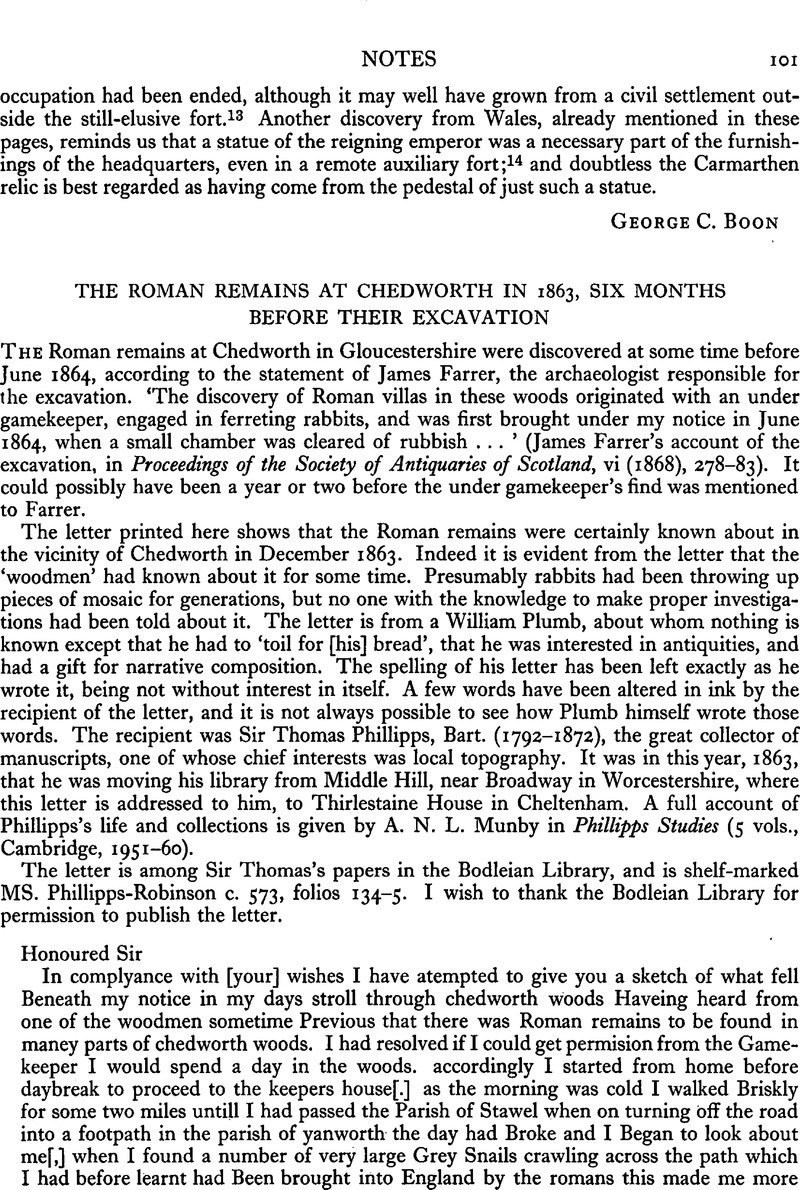No CrossRef data available.
Published online by Cambridge University Press: 29 November 2011

1 For excavations nearby and a plan of Moridunum, see James, H., Monographs & Collections (Cambrian Arch. Assn.), i (1978), pp. 63–106, figGoogle Scholar. ib.
2 Cf. Boube-Piccot, C., Les Bronzes antiques du Maroc (1969) i, pp. 37–40, with ii, pl. 257Google Scholar, for the clearest description and illustration of ‘la fonte en creux à la cire perdue sur négatif’.
3 And also on the reverse, where the bronze has split and broken away towards the top right, perhaps an attempt to repair it.
4 B.L. Add. MS. 6181, ff. 15–16; Ward, J., Phil. Trans, xlv, 1748, No. 490 (1750), 608–9, pl. 4Google Scholar.
5 R.I.B. i, no. 67.
6 Cf. Camden's, Gough's Britannia (1789 edn.), i, 141 Google Scholar. Duane died in 1785, and his coins and medals were sold in that year—his books, only in 1838; but the D.N.B. article says that as a Trustee of the British Museum he presented that institution with ‘minerals, antiquities, and miscellaneous objects’ between 1764 and 1777. Our Fellow, Miss C. M. Johns, kindly looked to see if there was any record of the Silchester pieces having been included, but to no avail.
7 Boon, G. C., Silchester: the Roman Town of Calleva (1974), pp. 110–11Google Scholar, cf. fig. 13.
8 B.L. Add. MS. 6212, f. 37 says (i.e. in a letter from Dr. John Collet of Newbury to Professor John Ward of Gresham College, Jan. 5, 1744/5) ‘… it is probable they were sawing it out for some other use, as appeared by the Stone Dust, and little broken pieces of Stone that lay all round about it, and the Stone itself appears as if it had been saw'd on the long broken side.’ In my Silchester, loc. cit., I overlooked the size of this pedestal in suggesting that the ‘frame’ went round it.
9 In B.L. Add. MS. 6181, loc. cit., Collet explains that he has not been able to obtain a satisfactory drawing of the frame, and promises one; but it is uncertain whether it was ever made, or if made, sent and received.
10 Pantheon, Sir Fletcher, Banister, A History of Architecture on the Comparative Method (1946 edn.), p. 121AGoogle Scholar; Nash, E., Pictorial Dictionary of Ancient Rome (1968 edn.), fig. 897 Google Scholar; Temple of Romulus, Nash, op. cit., fig. 1026.
11 Driehaus, J., Bonner Jahrbikher, clxix (1969), 424–36, Abb. 8Google Scholar.
12 Ibid., 429: ‘… so dass der Zusammenhalt auf einer Klemmwirkung beruhte, die Streifen demnach an den Ecken nicht verlotet zu werden brauchten.’ I doubt this.
13 Mention in Ptolemy's Geographike Hyphegesis of Maridounon points to there being a pre-Flavian fort, unattested archaeologically; but there is a very large amount of Flavian samian ware, and this must in itself indicate a fort of that period (cf. Dr Simpson, Grace, Arch. Camb. cxii (1963), 38)Google Scholar. The forts in West Wales seem all to have been given up under Hadrian, or by 150.
14 Boon, G. C., Antiq. J. lii (1972), 332–4, on a Segontium fragmentCrossRefGoogle Scholar .